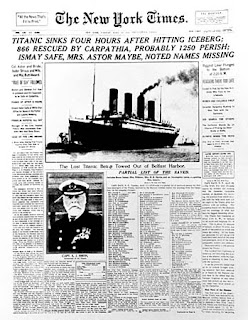To mark
the upcoming centenary anniversary of the Titanic sinking, I thought I would
look at gender roles in the movie (celebrating its 15th anniversary this
year, not as cool). The whole plot-line of the movie is about a woman who feels
repressed by a patriarchal society, so it seemed appropriate. Titanic is
arguably geared to a more feminine audience, but the roles of men comprise a
large part of the storyline.Todd Kappelman, writing a critique of Titanic (the movie), argues that the movie actually romanticizes sexism, and downplays gender inequality.
The
early 20th century culture was obsessed with masculinity and male
dominance. Women were starting to show their ankles and men felt there was just
no room for that kind of behavior. Back then, (as it is today in some cases),
manliness was based on power, and money=power. Some rich men in the movie did
exist in real life such as John Jacob Astor, Isadore Strauss, and Bruce Ismay
(the bosses boss, if you will). Others in the movie such as Caledon “Cal”
Hockley did not exist in real life. All of these wealthy characters in the
movie were shown as being part of a select group, think of them as the 1% of
1912.
These men were considered the most manly at the time because of their money,
and due to their wealth and genitals they could get away with almost anything.
J.J. Astor is introduced by Rose with his mistress who she claims was in a delicate
condition which was quite a scandal. This would not effect him negatively,It
would just make his young mistress carrying his illegitimate child look bad.
Today this woman would be given a publicist and a book deal, but that’s not how
it was back then.
James Cameron deliberately chose to include this dinner re-enactment
in his movie over hundreds of other factual anecdotes from the ship,perhaps to make a point about the subservient roles of women in 1912.
Cal
(Rose’s fiance’) is pretty much a huge dick the entire time…except when he
gives her a 20 ct diamond necklace, that was very sweet of him. Rose wants to
kill herself instead of marrying him, if that says anything about his
character. Arguably this was before he gave her the diamond, but she still didn’t
like him very much afterward either.
Cal is considered by high society to be
her perfect “match” because he was considered to be the ideal man of the time.
He came from a wealthy family, was successful, educated, handsome and
financially stable. Rose even went to a specific “finishing” school to find and
attract this type of guy, so that also tells you the emphasis people in 1912
placed on ideal masculinity. Again, James Cameron made sure to make his point about
the male dominated culture of the time.
By
Contrast we have Jack, who isn’t rich, but is also young and handsome. He is shown as a man’s man who drinks with
the guys and gets a lot of girls to get naked for him. While Rose falls for his
chivalrous nature, ultimately his lower class status and general lack of weight
distribution knowledge catches up to him when he dies at the end, as Cal and
other rich men were able to safely evacuate (even ahead of women and
children).
I guess the ultimate lesson
from the movie was that a man with money can always save himself, cause money is power, and power is what makes someone a man. Yes, Cal
kills himself during the stock market crash, but the point is he didn’t die
alongside the poor people on the ship. He was the "strongest" man, so therefore
he survived. Bruce Ismay also shows this money as power theory in the movie,
and in real life. Being the 1%er that he was, he also took a seat on the
lifeboats ahead of women and children, as others trying to do the exact same
thing were pushed back and/or shot. Ironically Bruce Ismay in real life went
down in history as a coward for this very stunt, taking away any hope of being
remembered as an awesome manly guy with a lot of money who built a big boat.
Finally
I have to discuss the scene where Cal is being a dick (again) and ordering Rose’s
food for her right down to the cooking temperature. Upon discussion of the
naming of Titanic, Rose brings up the point about how Freuds theories on the
male preoccupation with size to Bruce Ismay, the man who decided bigger was better (and thus meaning unsinkable).
This comment is met with laughs from fellow diners because an
upper-class woman made a penis joke, and is also met with shock from her mother. At this point it would take much more then
this comment to shock my mother, perhaps this is another reflection of the times. I was
10 when this movie came out, so I didn’t understand the phallic references
until at least a year or 2 later. I still felt that it was worth noting in here
that men have been worried about size, and compensating for it, for centuries.
But on a more serious note, over 1200 people died, arguably due to money and class. Many families lost husbands and fathers because of social masculinity structures, as the death-toll for men was much higher then that for women.






















